Travel Through India on a Harley-Davidson
By Peter & Kay Forwood
India on a Harley (28/2/07
- 27/3/07)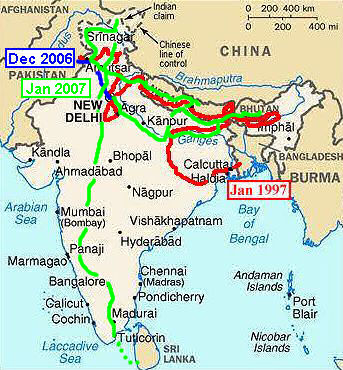
Distance 2183 km (488645 km to 490828 km)
This is part of the thirteenth section of our around
the world trip.
Complete Trip Overview & Map
Coming from Bhutan
or read our previous visit to India
28/2/07 Back to the bureaucracy that we have come to expect in India.
Whilst Bhutan was happy to process our passports without us being
present, in India we all waited roadside as each member of the group
was called in to be identified, the process taking an hour. We said
our goodbye's to everyone as our arrangement with Ferris Wheels Tours
finished here but as there had been political activist problems, some
militants having been killed, the region of Assam was on a 12 hour strike
till 5pm, we were requested to travel with the group at least till we
reached the main road, 40km away. Our plan was for a 350km day to Madari
Hat but after 150km's there was a roadblock. The military advised that
the road ahead was unsafe till after the strike finished at 5pm, too
late to reach our destination today so we found a hotel in Bongaigaon.
We had left the tour earlier, who had headed for a national park and
an elephant ride.
1/3/07 With the strike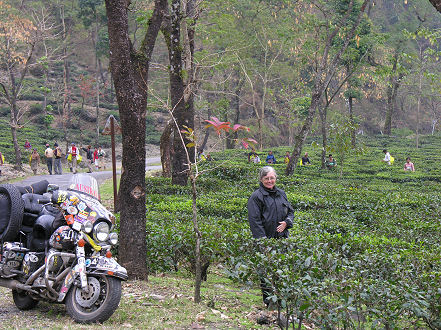 over, all of yesterday's traffic joined today's and packed
the roads. The state border between Assam and West Bengal had trucks
lined up on both sides waiting for permission to cross. Impatient they
had occupied both sides of the road and created gridlock with almost none
moving. We weaved in, out and around what we estimate to be over 1000 trucks
stuck in the couple of kilometre long traffic jam wondering how long they
would be stuck at the border, between two Indian states. We had intended
to rest up at Jaldhapara Wildlife Reserve but found the accommodation expensive
and not a good rest spot so continued on towards Mal. Just 10km short it
started to rain heavily, the worst time. Waiting an hour in a bus shelter
for the storm to pass was of no use, it was still raining as we arrived
at a hotel, wet.
over, all of yesterday's traffic joined today's and packed
the roads. The state border between Assam and West Bengal had trucks
lined up on both sides waiting for permission to cross. Impatient they
had occupied both sides of the road and created gridlock with almost none
moving. We weaved in, out and around what we estimate to be over 1000 trucks
stuck in the couple of kilometre long traffic jam wondering how long they
would be stuck at the border, between two Indian states. We had intended
to rest up at Jaldhapara Wildlife Reserve but found the accommodation expensive
and not a good rest spot so continued on towards Mal. Just 10km short it
started to rain heavily, the worst time. Waiting an hour in a bus shelter
for the storm to pass was of no use, it was still raining as we arrived
at a hotel, wet.
2/3/07 Still looking for a rest we were advised that the holiday of
colours, Holi, would start tomorrow and last for two days. This beginning
of spring festival on my visit to India ten years ago resulted in me
being held up at local roadblocks and being sprayed by coloured water
staining clothes. Decided to move onto Kalimpong where we could sit
out the festival.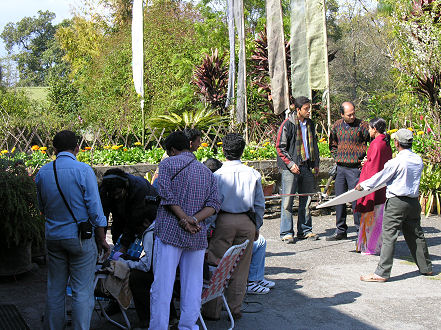 The rain had all but cleared and taking the mountain road through
Lava we twisted up through tea plantations and through forests of pines.
The rain had all but cleared and taking the mountain road through
Lava we twisted up through tea plantations and through forests of pines.
3/3/07 Few people in Kalimpong publicly celebrate Holi. Some children
were seen covered in red and blue dye but the widespread covering of
adults and motor vehicles I had seen last time doesn't occur here. We
walked the empty streets to the Himalayan Hotel. A century old western
icon in the area, the hotel is perched hilltop, with magnificent views
across to India's highest mountain, Khangchendzonga, showing its pointed,
snow covered peak in the distance. A slightly luxurious breakfast on the
upstairs terrace filled the morning. Another walk further up the hill to
a former maharaja's home, now hotel, for tea on the terrace, where a Kolkata
(Calcutta) film company was making a telemovie. The director and actors,
intrigued with our presence, were happy to talk about the movie business.
A seventy minute film it would be shot in three days and edited on the
spot, a low budget and tight time frame. There were some evening Holi celebrations
on the local football fields. A bonfire had been lit and people, many with
farm implements, chanted and sang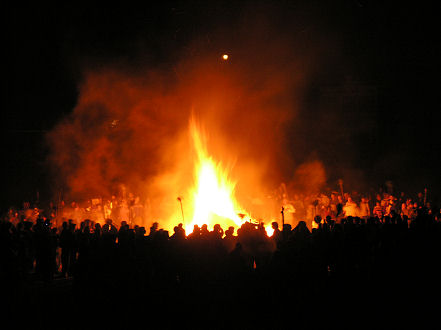 as they walked around the fire. Coals were later collected
on shovels and carried through town.
as they walked around the fire. Coals were later collected
on shovels and carried through town.
4/3/07 We have been eating too well on the Bhutan trip and now slipped
back to the two meals a day we normally eat when travelling, in an
effort to reduce weight. The weather was not so kind nor the mountains
in view as we retraced our steps to the Himalayan Hotel for late breakfast.
The whole of this mountain region across northern India only gets good
views, because of air pollution, after rain, once it washes away the
pollution particles. The clear air only lasts a day or two before more
pollution clouds the skies. Each year the population of India grows by more
than the entire population of Australia. 220 million more people live here
now than when we visited the country ten years ago. It seems we misjudged
the Holi celebrations. As we were resting in the Himalayan Hotel's gardens
the noise from back in town started to reach us. Ten young western volunteers,
happy to help celebrate, arrived covered in coloured dye. Even though
they had washed most off, it had stained their skin, hair and clothes.
By noon the noise had subsided and we ventured out of the hotel's grounds.
Coloured pavements dotted the town and silver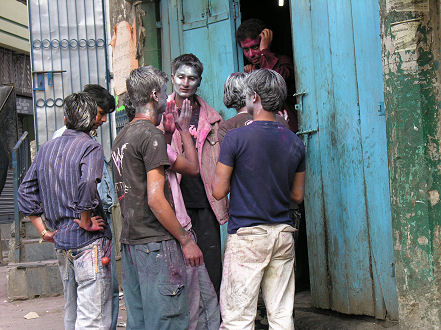 faced, red and blue skinned young people still strolled the
streets but the throwing of colours had finished.
faced, red and blue skinned young people still strolled the
streets but the throwing of colours had finished.
5/3/07 We used to cringe a little when we first started travelling
and met some Americans as often we thought them to be loud and complaining.
Since then Australians have also become louder and more complaining.
Unfortunately it is only through complaints, and often loud complaints
that things are improved. The squeaky door gets the oil. Poorer Indians
don't complain. They are crammed onto overcrowded buses. Squeezed into
ancient trains. Asked to line up for poor service and expected to wait
for just about everything. Consequently without complaints, or people
voting with their feet, or true free enterprise, things won't improve.
We are daily amazed by the acceptance in India when we find things that
only require small effort necessary to correct the problem. Sikkim is
one of India's border states that requires a permit for foreigners to
visit. It has only been an Indian state since 1975, but was incorporated
as a dependant territory in 1950, just before China annexed
Tibet, it's neighbour. Almost surrounded by China and claimed as part
of it's territory, even with permits, travellers are restricted where
they can go.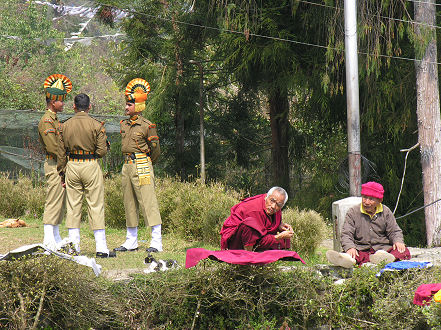 We arranged our permit at the state border at Rangpo,
just a few minutes, and moved onto the state capital, Gangtok, at 1700m.
Since the start of Nepal's political problems over the last few years
tourists have started to come here as an alternative trekking destination.
Still cold the season is just starting.
We arranged our permit at the state border at Rangpo,
just a few minutes, and moved onto the state capital, Gangtok, at 1700m.
Since the start of Nepal's political problems over the last few years
tourists have started to come here as an alternative trekking destination.
Still cold the season is just starting.
6/3/07 We are continuing our Buddhist tour of the region. Bhutan
is a Buddhist society as is most of Sikkim. Whilst Buddhism started just
500km to the south when Buddha first preached his "middle way" lifestyle
about 500 BC it has not been as accepted in India as in many other parts
of the world like Japan and Thailand. Perhaps this is because Hindus have
incorporated and swamped Buddhist teachings within their religion. When
China occupied Tibet many Buddhists moved south to Bhutan, Nepal and India.
The monastery nearby at Rumtek is a reproduction of one destroyed in Tibet.
Built mostly of concrete in 1960 it has little of the appeal of an ancient
monastery but functions as a teaching centre for the Black Hat sect. Tension
between India and China has prevented the new Karmapa (head of the sect),
currently in Dharamsala (west India), from taking up his seat at the monastery.
Military security is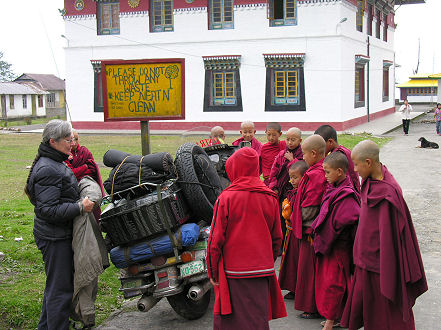 high, a metal detector and bag check at the entrance along
with armed patrolling soldiers within the grounds detract from the
serenity of the place.
high, a metal detector and bag check at the entrance along
with armed patrolling soldiers within the grounds detract from the
serenity of the place.
7/3/07 The Indian economy is growing at about 9%
and is heralded as a tiger however it is coming off a low base and it's
population increase and inflation disguise the net benefit. India's Gross
Domestic Product, the value of goods the entire country makes, is still
only slightly above the value of goods made in Australia. We produced little
today for either India or Australia. Talked with other travellers and a
bit of planning.
8/3/07 Part of the joy in coming back to a country is retracing our
steps in some regions, seeing how they have changed, or how our memory
has faded, and visiting previously unvisited areas. I was in this region
almost exactly ten years ago with a friend, Ron, who was travelling
on an Indian Enfield. The roads have improved but are still basic and
constantly under repair due to landslides. We rode to Phodong, with a
brief visit to the monastery, a fully functioning community place and
no soldiers. Then onto Singhik, a small village about as far north as it
is possible to visit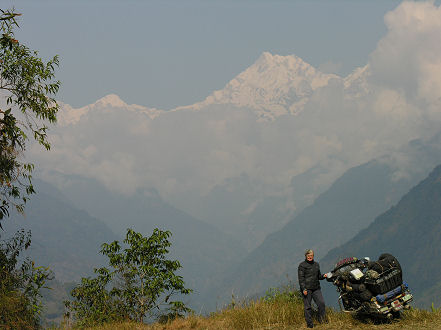 in Sikkim without special permits. Houses dot the hillsides
and we wondered how people support themselves in this poor region. It
seems only a couple of years ago India introduced a work plan where every
household gets a guaranteed 100 days minimum, manual labour each year,
probably working on the roads, effectively a work for unemployment benefits.
This underpins the economy which otherwise relies heavily on cardamom
production and subsistence farming. We stayed at the lovely Friendship
Guest House. A basic place, run by a few ladies it certainly lives up to
it's name, as they chuckle away amongst themselves in the kitchen making
our meals.
in Sikkim without special permits. Houses dot the hillsides
and we wondered how people support themselves in this poor region. It
seems only a couple of years ago India introduced a work plan where every
household gets a guaranteed 100 days minimum, manual labour each year,
probably working on the roads, effectively a work for unemployment benefits.
This underpins the economy which otherwise relies heavily on cardamom
production and subsistence farming. We stayed at the lovely Friendship
Guest House. A basic place, run by a few ladies it certainly lives up to
it's name, as they chuckle away amongst themselves in the kitchen making
our meals.
9/3/07 It rained last night and the air cleared enough to get a good
view of the mountain range, including Khangchendzonga,
the world's third highest. We headed back down the valley, following
the river, currently being dammed for hydroelectricity, before again
climbing the next mountain ridge, the way of riding in this area. Waterfalls
and mountain scenery all along the route with many landslides as these
mountains are being both pushed up by the continental plates and worn down
again by rain. Pelling for the night, same hotel as my last visit. The town
has grown, mostly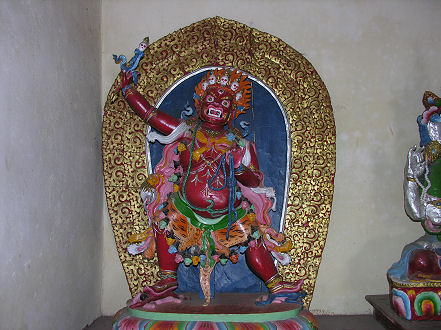 Bengali tourists coming up from the plains to avoid the summer
heat, hotels the main new construction.
Bengali tourists coming up from the plains to avoid the summer
heat, hotels the main new construction.
10/3/07 Buddhism has only been in this region of India since the 17th
century. A late comer compared to Bhutan whose history goes back to the 7th
century. Consequently there are no very old monasteries, but a couple do
date back to when Buddhism arrived. Sangachoeling Gompa is the second oldest
in Sikkim and has murals dating back to it's construction. Definitely phallic
in their depiction they show some of the eight manifestations of tantric
Buddha in sexual displays, a vast contrast to the South East Asian Buddha.
We walked the steep climb to the monastery where a road is under construction,
has been since 2003, supposed to be finished by 2004, and is likely still
years away from completion. Built entirely by hand, the road is dug out by
men, large stones separated, crushed by women and then concreted back into
retaining walls by men.
11/3/07 Pelling gets it's share of foreign backpacker tourists doing
treks between local towns and through the hills. A popular walk is
to Khecheopalri Lake,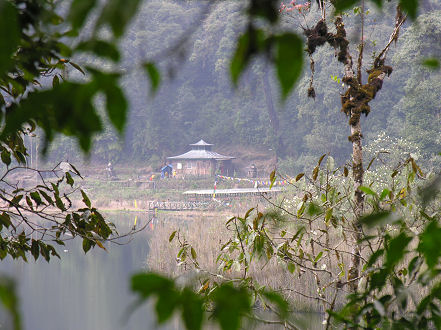 18km by foot or 25km by motorcycle our option. On our arrival a
youngish local man said he recognised the motorcycle. This has happened
before where people have seen a similar motorcycle or on TV but this gentleman
queried, "Didn't you used to have a painting of a tiger on the front
and not so many stickers?" It's ten years since I was here and the man
was then a young student. He had seen the motorcycle in his local town,
Legship, where Ron, travelling on an Enfield, and I had spent the night
in the police station, as the local hotel was full. The lake is unusual
in this area and is considered holy by locals although not that stunning
or spectacular it does sit beneath towering hills of dense temperate rainforest
with flowering magnolia and rhododendrons. We took a trail to walk around
the lake before returning to Pelling.
18km by foot or 25km by motorcycle our option. On our arrival a
youngish local man said he recognised the motorcycle. This has happened
before where people have seen a similar motorcycle or on TV but this gentleman
queried, "Didn't you used to have a painting of a tiger on the front
and not so many stickers?" It's ten years since I was here and the man
was then a young student. He had seen the motorcycle in his local town,
Legship, where Ron, travelling on an Enfield, and I had spent the night
in the police station, as the local hotel was full. The lake is unusual
in this area and is considered holy by locals although not that stunning
or spectacular it does sit beneath towering hills of dense temperate rainforest
with flowering magnolia and rhododendrons. We took a trail to walk around
the lake before returning to Pelling.
12/3/07 The skies had cleared and again Khangchendzonga
came out in full view. Neither needing to stay nor go we decided to stay
another night to socialise with other travellers and walk to another monastery,
almost monasteried out, our likely last in this region. Pelling has a
monastery a few km's from either end of the town. Pemayangtse, to the
east, has an intricate,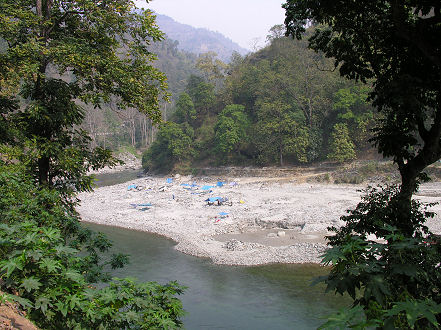 seven tiered, wooden sculpture depiction of Buddhism. Built by
a single man over five years it is quite impressive in it's detail.
seven tiered, wooden sculpture depiction of Buddhism. Built by
a single man over five years it is quite impressive in it's detail.
13/3/07 Time to leave. A ride back down the mountain to Legship, then
following the now withered river, hydro taking it's life, we arrived at Naya
Bazaar before leaving the state of Sikkim. I had remembered the ride from
here up to Darjeeling to be the steepest, most switchbacky road we have ever
been on and even after ten more years of riding it still remains the steepest
and most switchbacky road we have ever been on. The potholey, one vehicle
wide road, winding up through tea plantations, climbs 1600m in just 20km's.
The motorcycle was overheating and pinging coming out of many corners overloaded.
We rested and cooled the motorcycle before the final section of twists.
A local bike, with three riders, rode past with the chain slipping
on the front sprocket. We passed them later, stranded. The passenger jeeps
plod too slowly for our high range first gear and riding the clutch we had
to wait an opportunity to pass. Like the last time I arrived in Darjeeling
sleet welcomed us, taking refuge in an internet cafe for it to pass. It had
often surprised me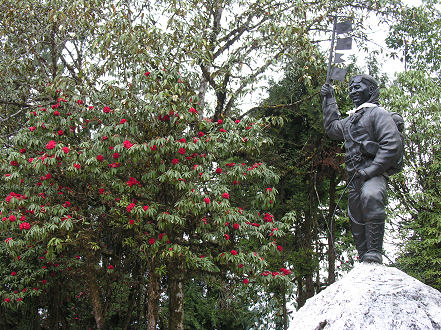 how hot the motorcycle got at cold altitudes. Air cooled
is not very efficient in the thin atmosphere.
how hot the motorcycle got at cold altitudes. Air cooled
is not very efficient in the thin atmosphere.
14/3/07 With the weather heating up on the plains of India we decided
to have a change of plans for this trip and will try to remain in the
Himalayan mountains of India, Nepal, Pakistan and perhaps China. We have
again been looking into getting the motorcycle into China but are having
little success. A couple of tour operators have said it is possible but
on further inquiry they find out that motorcycles are for some reason
more difficult than cars and as we want to cross more than one province
that adds another difficulty, a minimum of two months to get approval,
if it is successful, plus quite high expenses. It will be a long time to
spend in the region if we can't get into China. The motorcycle has been running
hotter than we would have expected since the rebuild with a resulting low
oil pressure. We opened the cam area and noticed the oil scavenge pump was
worn. It is likely it was caused by metal fragments from the cam follower
failure in Russia two years ago and needs replacement but we couldn't see
how it would be suddenly affecting oil flow and the high temperatures.
15/3/07 Awoke to clear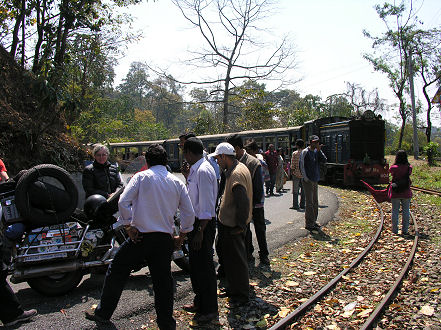 skies blown in from Tibet. An early morning walk to the viewpoints
gave stunning Himalayan views, snow-capped mountains peaking behind more
snow-capped mountains. Darjeeling is home to a large Tibetan community,
displaced when China occupied the territory. They brought with them their
hard work ethic and unique cuisine. Vegetable momo, slightly spiced
cabbage and onion wrapped in dough pastry has been our consistent favourite.
A takeaway order, wrapped in newspaper, because in a growing number of
Indian cities plastic carry bags are banned, either shows environmental
concern or an inability to recycle. A steamed item, the newsprint soon
rubs off on the momo's with the newspaper disintegrating from moisture.
skies blown in from Tibet. An early morning walk to the viewpoints
gave stunning Himalayan views, snow-capped mountains peaking behind more
snow-capped mountains. Darjeeling is home to a large Tibetan community,
displaced when China occupied the territory. They brought with them their
hard work ethic and unique cuisine. Vegetable momo, slightly spiced
cabbage and onion wrapped in dough pastry has been our consistent favourite.
A takeaway order, wrapped in newspaper, because in a growing number of
Indian cities plastic carry bags are banned, either shows environmental
concern or an inability to recycle. A steamed item, the newsprint soon
rubs off on the momo's with the newspaper disintegrating from moisture.
16/3/07 A transport strike, buses and trains are not running, shops
have their shutters drawn, restaurants are closed. Just about every business
in Darjeeling is closed in protest. The shooting killing yesterday, near
Kolkata, of 14 unarmed farm workers by police trying to remove them from
their land to convert it to industrial use the reason. Women and children,
caught up in the problem, were also injured and beaten. The mood of locals
is understandably angry.
The government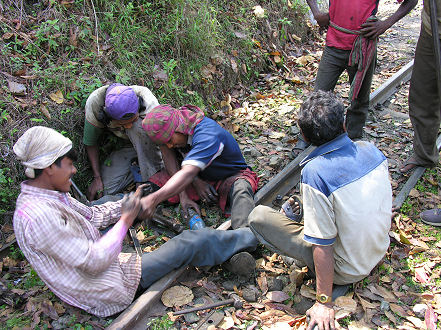 run tourist hotel we are staying in was once owned by the King
of Nepal and is heritage listed, with extensive views towards Nepal.
I think we are in the servant's quarters. A small room with
an attic like aspect. Despite it's heritage listing no maintenance is being
done and each evening the water is turned off to stop pipe and tap leakage.
Downstairs rooms remain damp from leaking drainage with mould and peeling
paint. We are staying here because it is quiet, has motorcycle parking
and above all a room heater, not seen by us in the last couple of cold
weeks. Darjeeling is largely a vehicle free town, situated on a ridge the
top few streets are pedestrian only. The British built the town and their
historic legacy of well laid out streets with parks and viewpoints remains
but concrete higher rise is replacing timber low rise. The older structures
seem to be only recently gaining restoration value and some upmarket hotels
are renovating. Government offices are about the only places open today.
That includes the Himalayan Mountaineering Institute which has good exhibits
of the conquest of Mt. Everest by Sir Edmund Hillary and Tenzing Norgay
in 1953 along with other Himalayan mountain conquests. Some of the clothes
they wore along with the two flags, a British and an Indian one, that they
placed on the top of Mt. Everest are on display. The nearby zoo,
run tourist hotel we are staying in was once owned by the King
of Nepal and is heritage listed, with extensive views towards Nepal.
I think we are in the servant's quarters. A small room with
an attic like aspect. Despite it's heritage listing no maintenance is being
done and each evening the water is turned off to stop pipe and tap leakage.
Downstairs rooms remain damp from leaking drainage with mould and peeling
paint. We are staying here because it is quiet, has motorcycle parking
and above all a room heater, not seen by us in the last couple of cold
weeks. Darjeeling is largely a vehicle free town, situated on a ridge the
top few streets are pedestrian only. The British built the town and their
historic legacy of well laid out streets with parks and viewpoints remains
but concrete higher rise is replacing timber low rise. The older structures
seem to be only recently gaining restoration value and some upmarket hotels
are renovating. Government offices are about the only places open today.
That includes the Himalayan Mountaineering Institute which has good exhibits
of the conquest of Mt. Everest by Sir Edmund Hillary and Tenzing Norgay
in 1953 along with other Himalayan mountain conquests. Some of the clothes
they wore along with the two flags, a British and an Indian one, that they
placed on the top of Mt. Everest are on display. The nearby zoo,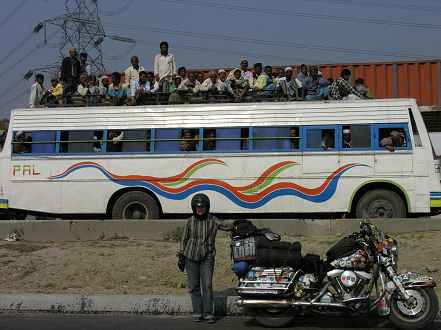 well appointed, has snow leopard, clouded leopard and red panda
as well as some more well known mountain species roaming large enclosures.
well appointed, has snow leopard, clouded leopard and red panda
as well as some more well known mountain species roaming large enclosures.
17/3/07 The "Toy" Train Railway from Siliguri to Darjeeling runs on
a 60cm track at just 10km/hr. It is often stopped due to track repairs. On
our way down the mountain we encountered it waiting for four men to hand drill
a hole in the tracks so they could bolt the repair together. Passengers had
disembarked and were waiting patiently. We took the opportunity to get some
photos as the weekend vehicle traffic passed carrying thousands of Indian
tourists up towards Darjeeling along the narrow road where often two
vehicles couldn't pass. Into Siliguri and finally found a tyre place that
was prepared to change a tubeless tyre. We had flown in to India with
the spare and the tour operator had carried it to and through Bhutan for
us but we were ready unload it. India's technology doesn't run to many
tubeless tyres and smaller tyre wallahs don't want to work on them. It
had required a large city to find someone.
18/3/07 We are back in "India", the India everyone thinks of. The
mountains are a quieter, more peaceful place to escape the thick crowds
and noisy traffic of the plains. The mountain people of Nepali and Tibetan origins
go about life at a quieter pace. Fitted the wheel back onto the motorcycle,
in front of a gathered crowd, after greasing the bearings, at our hotel's
entrance area. We now just throw the motorcycle onto it's side to remove
and replace the front wheel, requiring no assistance or special equipment.
of the plains. The mountain people of Nepali and Tibetan origins
go about life at a quieter pace. Fitted the wheel back onto the motorcycle,
in front of a gathered crowd, after greasing the bearings, at our hotel's
entrance area. We now just throw the motorcycle onto it's side to remove
and replace the front wheel, requiring no assistance or special equipment.
19/3/07 A couple of nights ago we walked across the main bridge into
Siliguri. There can be little as demeaning to a human than to have to
defecate, open to the public, on the sandy beaches of the river bed as
thousands walk above on the bridge. Squatting, thighs to mid back exposed,
hunched over. Thousands have done the same since the last rains as the
sandy beach was littered, barely room to walk between, till the next flooding
of the river to take it away and clean the area. Headed towards Bodhgaya,
some 600 km and needed to spend one night on the road in a small town. Some
of the road has improved, other sections are the same or worse than when
I travelled this difficult section ten years ago. At least 50% of the roads
we have travelled so far in India are under repair, and we are not sure
if it is a massive road building program, needed,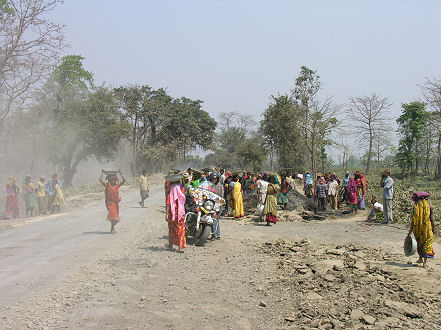 or whether this is the normal state of events as it takes so long,
done by hand, to build a road that it is disintegrating as fast as it
is built, probable. We are constantly told by Indian nationals that India
is now a "super power", it has nuclear weapons, can launch satellites by
itself, the newspapers are full of the latest achievements in technology,
how the west needs Indian call centres and computer programmers. CNN India
is running a series highlighting India's recent advancements, but there
is little improvement to see in the average lives of the average people.
After nine hours of almost constant riding we had travelled 350km to Begusarai
where the electricity was off and on all evening, something we have become
used to everywhere we stay. Euphemistically called load sharing, actually
rolling blackouts due to under supply and over use, lasting from seconds
to hours each day. We had passed through some magnificent country. Starting
with flatland tea plantations, pineapples, bananas and into vast acres
of grain crops. The area is so fertile, water so plentiful, that one crop
is being harvested as the next is planted and everywhere in between. Wetland
rice, dry land wheat, sunflowers, maize, oats, canola were all being grown.
or whether this is the normal state of events as it takes so long,
done by hand, to build a road that it is disintegrating as fast as it
is built, probable. We are constantly told by Indian nationals that India
is now a "super power", it has nuclear weapons, can launch satellites by
itself, the newspapers are full of the latest achievements in technology,
how the west needs Indian call centres and computer programmers. CNN India
is running a series highlighting India's recent advancements, but there
is little improvement to see in the average lives of the average people.
After nine hours of almost constant riding we had travelled 350km to Begusarai
where the electricity was off and on all evening, something we have become
used to everywhere we stay. Euphemistically called load sharing, actually
rolling blackouts due to under supply and over use, lasting from seconds
to hours each day. We had passed through some magnificent country. Starting
with flatland tea plantations, pineapples, bananas and into vast acres
of grain crops. The area is so fertile, water so plentiful, that one crop
is being harvested as the next is planted and everywhere in between. Wetland
rice, dry land wheat, sunflowers, maize, oats, canola were all being grown.
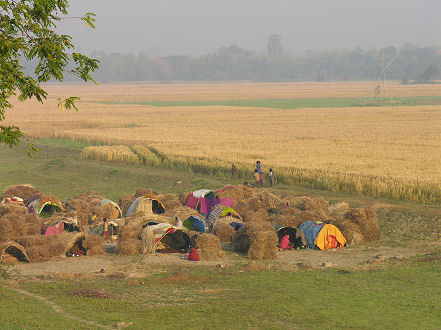 20/3/07 250km to Bodhgaya. The new road a marked difference to most
of yesterday's. Traffic was also light on the second half and after leaving
the main road we wandered through small villages living along the roadside
verge. Land is so precious none of the fertile bits are used for housing.
Water buffalo the mainstay animal. Milk for protein, dung is sundried in
biscuits for cooking, the animal harnessed it ploughs the fields. The countryside
gradually getting poorer and dryer the further south we went.
20/3/07 250km to Bodhgaya. The new road a marked difference to most
of yesterday's. Traffic was also light on the second half and after leaving
the main road we wandered through small villages living along the roadside
verge. Land is so precious none of the fertile bits are used for housing.
Water buffalo the mainstay animal. Milk for protein, dung is sundried in
biscuits for cooking, the animal harnessed it ploughs the fields. The countryside
gradually getting poorer and dryer the further south we went.
21/3/07 Bodhgaya is where Buddha found enlightenment under the Bodhi
tree, a descendant of the original, 2600 years ago, still thrives. Since
then monasteries and temples from Buddhist communities around the world
have been built in the town. Japan, Thailand, Burma, Tibet, Bhutan, China,
Nepal, Vietnam and the first Indian temple, built about 200BC, all dedicate
this site as the most holy of Buddhist places in the world. We were at the
Mahabodhi Temple, built on the site where Buddha found enlightenment, early
in the morning and watched the faithful meditate 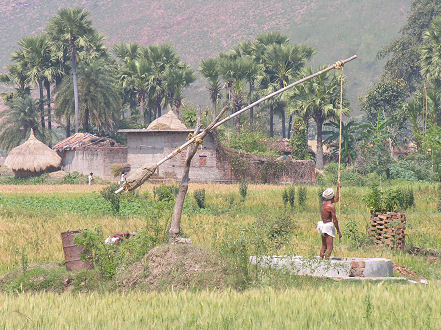 or slowly file past the place where Buddha had sat. There is currently
a large contingent of Thai Buddhists, celebrating the 50th anniversary
of their monastery in Bodhgaya making the place busier and more interesting
than usual. More than 100 French Buddhists are also here. Of the Tibetan
faith they have a Chinese Master in France and are here to reopen the
Chinese Temple, closed for many years due to the poor relationship between
India and China, but now the temple has been renovated and will open in
a few day's time. A couple of Belgian Buddhists, travelling the Buddha trail
independently, shared our restaurant table along with many other nationalities,
some Buddhists, others like us just interested in the teachings and followings.
or slowly file past the place where Buddha had sat. There is currently
a large contingent of Thai Buddhists, celebrating the 50th anniversary
of their monastery in Bodhgaya making the place busier and more interesting
than usual. More than 100 French Buddhists are also here. Of the Tibetan
faith they have a Chinese Master in France and are here to reopen the
Chinese Temple, closed for many years due to the poor relationship between
India and China, but now the temple has been renovated and will open in
a few day's time. A couple of Belgian Buddhists, travelling the Buddha trail
independently, shared our restaurant table along with many other nationalities,
some Buddhists, others like us just interested in the teachings and followings.
22/3/07 We had come here thinking to do a meditation course. We have
met many travellers who do meditation and often wondered it's benefits.
A course often lasts ten days, starting at 4am till 10pm each day, meditating
for over ten hours in that time, some sitting, some walking meditation.
A little intensive we chose to first try a couple of sessions. Last night
we spent a pleasant hour at the Japanese Temple, meditating Zen style to
the ringing of a range of bells and drums as well as sitting silently.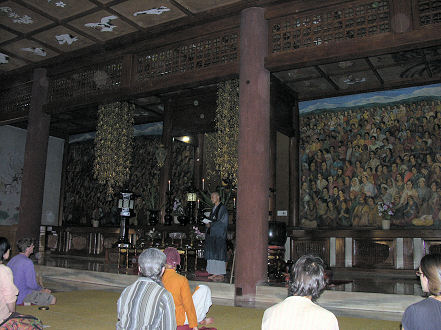 The Japanese Temple is one of the simplest in design reflecting
the Zen style of minimalism, contrasting vastly from the Thailand and
Bhutan Monasteries. This morning we joined the many people in quiet solitude
meditating or supplicating away from the busy bustle of the city inside
the Mahabodhi Temple grounds. The days on the plains are already hot and
most tourists spend the heat of the day in their hotel rooms, coming out
at dawn and dusk. Tourists will soon disappear from this region as the heat
build up to the monsoon arrives making it unbearable for people of European
origins.
The Japanese Temple is one of the simplest in design reflecting
the Zen style of minimalism, contrasting vastly from the Thailand and
Bhutan Monasteries. This morning we joined the many people in quiet solitude
meditating or supplicating away from the busy bustle of the city inside
the Mahabodhi Temple grounds. The days on the plains are already hot and
most tourists spend the heat of the day in their hotel rooms, coming out
at dawn and dusk. Tourists will soon disappear from this region as the heat
build up to the monsoon arrives making it unbearable for people of European
origins.
23/3/07 A bit of yoga this morning, something we have also not tried
before. An hour and a half with a Nepalese yoga instructor, who was taught
by an Israeli master, at a Korean owned business with Indian staff indicates
the international makeup of this place. Quite a relaxed event with Kay
and I the only participants, the instructor paced things to our abilities.
The early evening was again spent at the Japanese Monastery in Zen meditation,
which we again enjoyed, this time with about 15 other tourist meditators.
With the hectic nature of travelling in India meditation can easily help
to reduce the stress of traffic, traffic noise, beggars and poverty that
often drives tourists to annoyance beyond enjoyment. After both meditation
sessions we have come away with an air of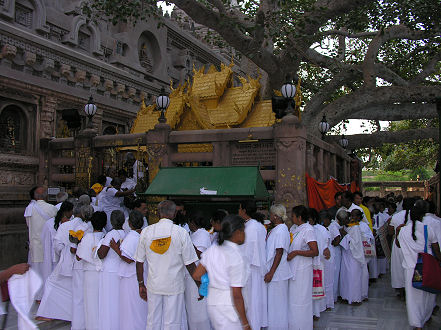 aloofness to our surroundings, unfortunately it is not a lasting
effect. Other tourists have become engrossed in the process. Some spending
months here, repeating meditation courses, seeking and finding a different
direction or way of life to take back to their home country.
aloofness to our surroundings, unfortunately it is not a lasting
effect. Other tourists have become engrossed in the process. Some spending
months here, repeating meditation courses, seeking and finding a different
direction or way of life to take back to their home country.
24/3/07 Mahabodhi Temple was cleaned up for today's Princess of Thailand's
visit. The street sellers and beggars that usually wait around the entrance
area were gone. Extra flowers and welcoming ribbons were draped and people,
like us, were told we could not sit on the grass, something we, and others,
have been doing for the last few days, in peace and quiet. Armed military
strolled through the temple grounds and it was no longer the peaceful
place we had been enjoying.
25/3/07 Another Hindu festival. This time people, mostly women, go
down to the local water hole to make an offering or enter the water. As
we travelled the 250km to Sarnath, just north of Varanasi, leaving at
dawn to avoid the heat and traffic, we passed many small celebrating villages.
The road was good but the four lane GT road was unfinished and as we have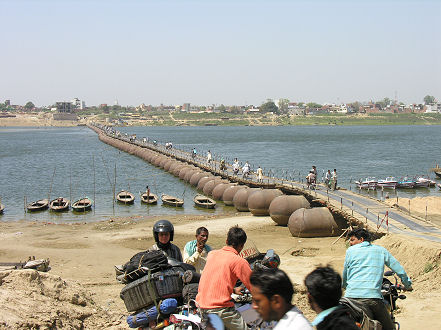 come to expect on divided roads they are often treated as just
two, two lane roads, with vehicles going in both directions on both roads.
A couple more horrendous head on accidents leaving wreckage along the road,
the result. At the state border, the usual line up of waiting trucks was
compounded by a truck having broken down in the middle of a bridge. With
trucks unable to pass from either direction they waited. We counted over
500 immobile trucks stranded on just one side, with more arriving every
minute. There was little prospect of repairing or towing the broken truck
as other vehicles had gridlocked it firmly on the bridge. We manoeuvred
slowly through the melee. Following the road signs we arrived at the double
decker, road/rail bridge over the Ganges River near Varanasi only to
find that vehicles are no longer allowed to cross. A detour to a narrow
floating pontoon bridge a few km's down river had us in Varanasi traffic,
and onto Sarnath.
come to expect on divided roads they are often treated as just
two, two lane roads, with vehicles going in both directions on both roads.
A couple more horrendous head on accidents leaving wreckage along the road,
the result. At the state border, the usual line up of waiting trucks was
compounded by a truck having broken down in the middle of a bridge. With
trucks unable to pass from either direction they waited. We counted over
500 immobile trucks stranded on just one side, with more arriving every
minute. There was little prospect of repairing or towing the broken truck
as other vehicles had gridlocked it firmly on the bridge. We manoeuvred
slowly through the melee. Following the road signs we arrived at the double
decker, road/rail bridge over the Ganges River near Varanasi only to
find that vehicles are no longer allowed to cross. A detour to a narrow
floating pontoon bridge a few km's down river had us in Varanasi traffic,
and onto Sarnath.
26/3/07 Our government tourist hotel is where the Dalai Lama resided
for over a month on his pilgrimage to the area 50 years ago. Sarnath is
where Buddha preached his first sermon after gaining enlightenment in
Bodhgaya. Again there are many temples from the world's followers. The
Sri Lankan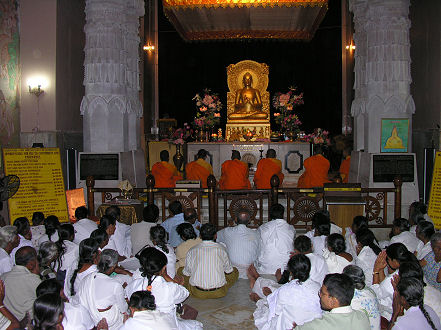 temple has a "service" (Buddhism is not necessarily considered
a religion but a way of life by many followers) with a reciting of Buddha's
first sermon carried out here every evening. We joined a couple of hundred
Sri Lankan pilgrims sitting on the floor of the temple who recited the
sermon last evening. Today we visited the museum and ruins, along with many
hundreds of pilgrims from all over the world, the exact place where Buddha
has been identified as preaching his first sermon to five followers, now
surrounded by many monastery ruins from the 5th and 12th century. Unfortunately
the experience was marred by one of my pet hates. Non Indians are charges
20 times the entrance fee of India nationals. Not a large amount, however
this world class religious site is not the place for this two "caste" system.
Not just westerners, Sri Lankan pilgrims, and all other poorer nation's pilgrims
are asked to pay this higher charge, while Indians, irrespective of their
wealth or religious association with the site, pay the "discriminatory" different
price. If any western nation tried to do the same at such an historically
important religious site it would receive universal criticism as should the
Indian Government.
temple has a "service" (Buddhism is not necessarily considered
a religion but a way of life by many followers) with a reciting of Buddha's
first sermon carried out here every evening. We joined a couple of hundred
Sri Lankan pilgrims sitting on the floor of the temple who recited the
sermon last evening. Today we visited the museum and ruins, along with many
hundreds of pilgrims from all over the world, the exact place where Buddha
has been identified as preaching his first sermon to five followers, now
surrounded by many monastery ruins from the 5th and 12th century. Unfortunately
the experience was marred by one of my pet hates. Non Indians are charges
20 times the entrance fee of India nationals. Not a large amount, however
this world class religious site is not the place for this two "caste" system.
Not just westerners, Sri Lankan pilgrims, and all other poorer nation's pilgrims
are asked to pay this higher charge, while Indians, irrespective of their
wealth or religious association with the site, pay the "discriminatory" different
price. If any western nation tried to do the same at such an historically
important religious site it would receive universal criticism as should the
Indian Government.
27/3/07 Straight through to the Nepal border at Sonauli following
the same route we did two months ago. The road is still good with light
traffic and this time we managed not to get lost in Gorakhpur. The border
here is quick and efficient and we were out of India in under half an hour.
The customs officer reconfirmed India's rules on carnet imported vehicles.
There is a maximum 6 month stay in India, including time in Nepal or Bhutan,
else the vehicle is deemed to have been imported and duty, he thinks 150%,
is payable, and will be claimed against the carnet. Leaving through the borders
of Bangladesh or Pakistan and returning start the 6 months again. We have
to be careful to leave to Pakistan before mid June. Whether the authorities
will match up the original entry to the region with the final departure,
as each entry to Nepal cancels a page in the carnet, is doubtful, but the
risk is too high to ignore the situation.
Move with us to Nepal or go to our next
visit to India
 over, all of yesterday's traffic joined today's and packed
the roads. The state border between Assam and West Bengal had trucks
lined up on both sides waiting for permission to cross. Impatient they
had occupied both sides of the road and created gridlock with almost none
moving. We weaved in, out and around what we estimate to be over 1000 trucks
stuck in the couple of kilometre long traffic jam wondering how long they
would be stuck at the border, between two Indian states. We had intended
to rest up at Jaldhapara Wildlife Reserve but found the accommodation expensive
and not a good rest spot so continued on towards Mal. Just 10km short it
started to rain heavily, the worst time. Waiting an hour in a bus shelter
for the storm to pass was of no use, it was still raining as we arrived
at a hotel, wet.
over, all of yesterday's traffic joined today's and packed
the roads. The state border between Assam and West Bengal had trucks
lined up on both sides waiting for permission to cross. Impatient they
had occupied both sides of the road and created gridlock with almost none
moving. We weaved in, out and around what we estimate to be over 1000 trucks
stuck in the couple of kilometre long traffic jam wondering how long they
would be stuck at the border, between two Indian states. We had intended
to rest up at Jaldhapara Wildlife Reserve but found the accommodation expensive
and not a good rest spot so continued on towards Mal. Just 10km short it
started to rain heavily, the worst time. Waiting an hour in a bus shelter
for the storm to pass was of no use, it was still raining as we arrived
at a hotel, wet. 
 The rain had all but cleared and taking the mountain road through
Lava we twisted up through tea plantations and through forests of pines.
The rain had all but cleared and taking the mountain road through
Lava we twisted up through tea plantations and through forests of pines.
 as they walked around the fire. Coals were later collected
on shovels and carried through town.
as they walked around the fire. Coals were later collected
on shovels and carried through town.  faced, red and blue skinned young people still strolled the
streets but the throwing of colours had finished.
faced, red and blue skinned young people still strolled the
streets but the throwing of colours had finished.  We arranged our permit at the state border at Rangpo,
just a few minutes, and moved onto the state capital, Gangtok, at 1700m.
Since the start of Nepal's political problems over the last few years
tourists have started to come here as an alternative trekking destination.
Still cold the season is just starting.
We arranged our permit at the state border at Rangpo,
just a few minutes, and moved onto the state capital, Gangtok, at 1700m.
Since the start of Nepal's political problems over the last few years
tourists have started to come here as an alternative trekking destination.
Still cold the season is just starting. high, a metal detector and bag check at the entrance along
with armed patrolling soldiers within the grounds detract from the
serenity of the place.
high, a metal detector and bag check at the entrance along
with armed patrolling soldiers within the grounds detract from the
serenity of the place.  in Sikkim without special permits. Houses dot the hillsides
and we wondered how people support themselves in this poor region. It
seems only a couple of years ago India introduced a work plan where every
household gets a guaranteed 100 days minimum, manual labour each year,
probably working on the roads, effectively a work for unemployment benefits.
This underpins the economy which otherwise relies heavily on cardamom
production and subsistence farming. We stayed at the lovely Friendship
Guest House. A basic place, run by a few ladies it certainly lives up to
it's name, as they chuckle away amongst themselves in the kitchen making
our meals.
in Sikkim without special permits. Houses dot the hillsides
and we wondered how people support themselves in this poor region. It
seems only a couple of years ago India introduced a work plan where every
household gets a guaranteed 100 days minimum, manual labour each year,
probably working on the roads, effectively a work for unemployment benefits.
This underpins the economy which otherwise relies heavily on cardamom
production and subsistence farming. We stayed at the lovely Friendship
Guest House. A basic place, run by a few ladies it certainly lives up to
it's name, as they chuckle away amongst themselves in the kitchen making
our meals. Bengali tourists coming up from the plains to avoid the summer
heat, hotels the main new construction.
Bengali tourists coming up from the plains to avoid the summer
heat, hotels the main new construction. 18km by foot or 25km by motorcycle our option. On our arrival a
youngish local man said he recognised the motorcycle. This has happened
before where people have seen a similar motorcycle or on TV but this gentleman
queried, "Didn't you used to have a painting of a tiger on the front
and not so many stickers?" It's ten years since I was here and the man
was then a young student. He had seen the motorcycle in his local town,
Legship, where Ron, travelling on an Enfield, and I had spent the night
in the police station, as the local hotel was full. The lake is unusual
in this area and is considered holy by locals although not that stunning
or spectacular it does sit beneath towering hills of dense temperate rainforest
with flowering magnolia and rhododendrons. We took a trail to walk around
the lake before returning to Pelling.
18km by foot or 25km by motorcycle our option. On our arrival a
youngish local man said he recognised the motorcycle. This has happened
before where people have seen a similar motorcycle or on TV but this gentleman
queried, "Didn't you used to have a painting of a tiger on the front
and not so many stickers?" It's ten years since I was here and the man
was then a young student. He had seen the motorcycle in his local town,
Legship, where Ron, travelling on an Enfield, and I had spent the night
in the police station, as the local hotel was full. The lake is unusual
in this area and is considered holy by locals although not that stunning
or spectacular it does sit beneath towering hills of dense temperate rainforest
with flowering magnolia and rhododendrons. We took a trail to walk around
the lake before returning to Pelling. seven tiered, wooden sculpture depiction of Buddhism. Built by
a single man over five years it is quite impressive in it's detail.
seven tiered, wooden sculpture depiction of Buddhism. Built by
a single man over five years it is quite impressive in it's detail.  how hot the motorcycle got at cold altitudes. Air cooled
is not very efficient in the thin atmosphere.
how hot the motorcycle got at cold altitudes. Air cooled
is not very efficient in the thin atmosphere.  skies blown in from Tibet. An early morning walk to the viewpoints
gave stunning Himalayan views, snow-capped mountains peaking behind more
snow-capped mountains. Darjeeling is home to a large Tibetan community,
displaced when China occupied the territory. They brought with them their
hard work ethic and unique cuisine. Vegetable momo, slightly spiced
cabbage and onion wrapped in dough pastry has been our consistent favourite.
A takeaway order, wrapped in newspaper, because in a growing number of
Indian cities plastic carry bags are banned, either shows environmental
concern or an inability to recycle. A steamed item, the newsprint soon
rubs off on the momo's with the newspaper disintegrating from moisture.
skies blown in from Tibet. An early morning walk to the viewpoints
gave stunning Himalayan views, snow-capped mountains peaking behind more
snow-capped mountains. Darjeeling is home to a large Tibetan community,
displaced when China occupied the territory. They brought with them their
hard work ethic and unique cuisine. Vegetable momo, slightly spiced
cabbage and onion wrapped in dough pastry has been our consistent favourite.
A takeaway order, wrapped in newspaper, because in a growing number of
Indian cities plastic carry bags are banned, either shows environmental
concern or an inability to recycle. A steamed item, the newsprint soon
rubs off on the momo's with the newspaper disintegrating from moisture.
 run tourist hotel we are staying in was once owned by the King
of Nepal and is heritage listed, with extensive views towards Nepal.
I think we are in the servant's quarters. A small room with
an attic like aspect. Despite it's heritage listing no maintenance is being
done and each evening the water is turned off to stop pipe and tap leakage.
Downstairs rooms remain damp from leaking drainage with mould and peeling
paint. We are staying here because it is quiet, has motorcycle parking
and above all a room heater, not seen by us in the last couple of cold
weeks. Darjeeling is largely a vehicle free town, situated on a ridge the
top few streets are pedestrian only. The British built the town and their
historic legacy of well laid out streets with parks and viewpoints remains
but concrete higher rise is replacing timber low rise. The older structures
seem to be only recently gaining restoration value and some upmarket hotels
are renovating. Government offices are about the only places open today.
That includes the Himalayan Mountaineering Institute which has good exhibits
of the conquest of Mt. Everest by Sir Edmund Hillary and Tenzing Norgay
in 1953 along with other Himalayan mountain conquests. Some of the clothes
they wore along with the two flags, a British and an Indian one, that they
placed on the top of Mt. Everest are on display. The nearby zoo,
run tourist hotel we are staying in was once owned by the King
of Nepal and is heritage listed, with extensive views towards Nepal.
I think we are in the servant's quarters. A small room with
an attic like aspect. Despite it's heritage listing no maintenance is being
done and each evening the water is turned off to stop pipe and tap leakage.
Downstairs rooms remain damp from leaking drainage with mould and peeling
paint. We are staying here because it is quiet, has motorcycle parking
and above all a room heater, not seen by us in the last couple of cold
weeks. Darjeeling is largely a vehicle free town, situated on a ridge the
top few streets are pedestrian only. The British built the town and their
historic legacy of well laid out streets with parks and viewpoints remains
but concrete higher rise is replacing timber low rise. The older structures
seem to be only recently gaining restoration value and some upmarket hotels
are renovating. Government offices are about the only places open today.
That includes the Himalayan Mountaineering Institute which has good exhibits
of the conquest of Mt. Everest by Sir Edmund Hillary and Tenzing Norgay
in 1953 along with other Himalayan mountain conquests. Some of the clothes
they wore along with the two flags, a British and an Indian one, that they
placed on the top of Mt. Everest are on display. The nearby zoo, well appointed, has snow leopard, clouded leopard and red panda
as well as some more well known mountain species roaming large enclosures.
well appointed, has snow leopard, clouded leopard and red panda
as well as some more well known mountain species roaming large enclosures. of the plains. The mountain people of Nepali and Tibetan origins
go about life at a quieter pace. Fitted the wheel back onto the motorcycle,
in front of a gathered crowd, after greasing the bearings, at our hotel's
entrance area. We now just throw the motorcycle onto it's side to remove
and replace the front wheel, requiring no assistance or special equipment.
of the plains. The mountain people of Nepali and Tibetan origins
go about life at a quieter pace. Fitted the wheel back onto the motorcycle,
in front of a gathered crowd, after greasing the bearings, at our hotel's
entrance area. We now just throw the motorcycle onto it's side to remove
and replace the front wheel, requiring no assistance or special equipment.
 or whether this is the normal state of events as it takes so long,
done by hand, to build a road that it is disintegrating as fast as it
is built, probable. We are constantly told by Indian nationals that India
is now a "super power", it has nuclear weapons, can launch satellites by
itself, the newspapers are full of the latest achievements in technology,
how the west needs Indian call centres and computer programmers. CNN India
is running a series highlighting India's recent advancements, but there
is little improvement to see in the average lives of the average people.
After nine hours of almost constant riding we had travelled 350km to Begusarai
where the electricity was off and on all evening, something we have become
used to everywhere we stay. Euphemistically called load sharing, actually
rolling blackouts due to under supply and over use, lasting from seconds
to hours each day. We had passed through some magnificent country. Starting
with flatland tea plantations, pineapples, bananas and into vast acres
of grain crops. The area is so fertile, water so plentiful, that one crop
is being harvested as the next is planted and everywhere in between. Wetland
rice, dry land wheat, sunflowers, maize, oats, canola were all being grown.
or whether this is the normal state of events as it takes so long,
done by hand, to build a road that it is disintegrating as fast as it
is built, probable. We are constantly told by Indian nationals that India
is now a "super power", it has nuclear weapons, can launch satellites by
itself, the newspapers are full of the latest achievements in technology,
how the west needs Indian call centres and computer programmers. CNN India
is running a series highlighting India's recent advancements, but there
is little improvement to see in the average lives of the average people.
After nine hours of almost constant riding we had travelled 350km to Begusarai
where the electricity was off and on all evening, something we have become
used to everywhere we stay. Euphemistically called load sharing, actually
rolling blackouts due to under supply and over use, lasting from seconds
to hours each day. We had passed through some magnificent country. Starting
with flatland tea plantations, pineapples, bananas and into vast acres
of grain crops. The area is so fertile, water so plentiful, that one crop
is being harvested as the next is planted and everywhere in between. Wetland
rice, dry land wheat, sunflowers, maize, oats, canola were all being grown. 20/3/07 250km to Bodhgaya. The new road a marked difference to most
of yesterday's. Traffic was also light on the second half and after leaving
the main road we wandered through small villages living along the roadside
verge. Land is so precious none of the fertile bits are used for housing.
Water buffalo the mainstay animal. Milk for protein, dung is sundried in
biscuits for cooking, the animal harnessed it ploughs the fields. The countryside
gradually getting poorer and dryer the further south we went.
20/3/07 250km to Bodhgaya. The new road a marked difference to most
of yesterday's. Traffic was also light on the second half and after leaving
the main road we wandered through small villages living along the roadside
verge. Land is so precious none of the fertile bits are used for housing.
Water buffalo the mainstay animal. Milk for protein, dung is sundried in
biscuits for cooking, the animal harnessed it ploughs the fields. The countryside
gradually getting poorer and dryer the further south we went.  or slowly file past the place where Buddha had sat. There is currently
a large contingent of Thai Buddhists, celebrating the 50th anniversary
of their monastery in Bodhgaya making the place busier and more interesting
than usual. More than 100 French Buddhists are also here. Of the Tibetan
faith they have a Chinese Master in France and are here to reopen the
Chinese Temple, closed for many years due to the poor relationship between
India and China, but now the temple has been renovated and will open in
a few day's time. A couple of Belgian Buddhists, travelling the Buddha trail
independently, shared our restaurant table along with many other nationalities,
some Buddhists, others like us just interested in the teachings and followings.
or slowly file past the place where Buddha had sat. There is currently
a large contingent of Thai Buddhists, celebrating the 50th anniversary
of their monastery in Bodhgaya making the place busier and more interesting
than usual. More than 100 French Buddhists are also here. Of the Tibetan
faith they have a Chinese Master in France and are here to reopen the
Chinese Temple, closed for many years due to the poor relationship between
India and China, but now the temple has been renovated and will open in
a few day's time. A couple of Belgian Buddhists, travelling the Buddha trail
independently, shared our restaurant table along with many other nationalities,
some Buddhists, others like us just interested in the teachings and followings.
 The Japanese Temple is one of the simplest in design reflecting
the Zen style of minimalism, contrasting vastly from the Thailand and
Bhutan Monasteries. This morning we joined the many people in quiet solitude
meditating or supplicating away from the busy bustle of the city inside
the Mahabodhi Temple grounds. The days on the plains are already hot and
most tourists spend the heat of the day in their hotel rooms, coming out
at dawn and dusk. Tourists will soon disappear from this region as the heat
build up to the monsoon arrives making it unbearable for people of European
origins.
The Japanese Temple is one of the simplest in design reflecting
the Zen style of minimalism, contrasting vastly from the Thailand and
Bhutan Monasteries. This morning we joined the many people in quiet solitude
meditating or supplicating away from the busy bustle of the city inside
the Mahabodhi Temple grounds. The days on the plains are already hot and
most tourists spend the heat of the day in their hotel rooms, coming out
at dawn and dusk. Tourists will soon disappear from this region as the heat
build up to the monsoon arrives making it unbearable for people of European
origins.  aloofness to our surroundings, unfortunately it is not a lasting
effect. Other tourists have become engrossed in the process. Some spending
months here, repeating meditation courses, seeking and finding a different
direction or way of life to take back to their home country.
aloofness to our surroundings, unfortunately it is not a lasting
effect. Other tourists have become engrossed in the process. Some spending
months here, repeating meditation courses, seeking and finding a different
direction or way of life to take back to their home country.  come to expect on divided roads they are often treated as just
two, two lane roads, with vehicles going in both directions on both roads.
A couple more horrendous head on accidents leaving wreckage along the road,
the result. At the state border, the usual line up of waiting trucks was
compounded by a truck having broken down in the middle of a bridge. With
trucks unable to pass from either direction they waited. We counted over
500 immobile trucks stranded on just one side, with more arriving every
minute. There was little prospect of repairing or towing the broken truck
as other vehicles had gridlocked it firmly on the bridge. We manoeuvred
slowly through the melee. Following the road signs we arrived at the double
decker, road/rail bridge over the Ganges River near Varanasi only to
find that vehicles are no longer allowed to cross. A detour to a narrow
floating pontoon bridge a few km's down river had us in Varanasi traffic,
and onto Sarnath.
come to expect on divided roads they are often treated as just
two, two lane roads, with vehicles going in both directions on both roads.
A couple more horrendous head on accidents leaving wreckage along the road,
the result. At the state border, the usual line up of waiting trucks was
compounded by a truck having broken down in the middle of a bridge. With
trucks unable to pass from either direction they waited. We counted over
500 immobile trucks stranded on just one side, with more arriving every
minute. There was little prospect of repairing or towing the broken truck
as other vehicles had gridlocked it firmly on the bridge. We manoeuvred
slowly through the melee. Following the road signs we arrived at the double
decker, road/rail bridge over the Ganges River near Varanasi only to
find that vehicles are no longer allowed to cross. A detour to a narrow
floating pontoon bridge a few km's down river had us in Varanasi traffic,
and onto Sarnath. temple has a "service" (Buddhism is not necessarily considered
a religion but a way of life by many followers) with a reciting of Buddha's
first sermon carried out here every evening. We joined a couple of hundred
Sri Lankan pilgrims sitting on the floor of the temple who recited the
sermon last evening. Today we visited the museum and ruins, along with many
hundreds of pilgrims from all over the world, the exact place where Buddha
has been identified as preaching his first sermon to five followers, now
surrounded by many monastery ruins from the 5th and 12th century. Unfortunately
the experience was marred by one of my pet hates. Non Indians are charges
20 times the entrance fee of India nationals. Not a large amount, however
this world class religious site is not the place for this two "caste" system.
Not just westerners, Sri Lankan pilgrims, and all other poorer nation's pilgrims
are asked to pay this higher charge, while Indians, irrespective of their
wealth or religious association with the site, pay the "discriminatory" different
price. If any western nation tried to do the same at such an historically
important religious site it would receive universal criticism as should the
Indian Government.
temple has a "service" (Buddhism is not necessarily considered
a religion but a way of life by many followers) with a reciting of Buddha's
first sermon carried out here every evening. We joined a couple of hundred
Sri Lankan pilgrims sitting on the floor of the temple who recited the
sermon last evening. Today we visited the museum and ruins, along with many
hundreds of pilgrims from all over the world, the exact place where Buddha
has been identified as preaching his first sermon to five followers, now
surrounded by many monastery ruins from the 5th and 12th century. Unfortunately
the experience was marred by one of my pet hates. Non Indians are charges
20 times the entrance fee of India nationals. Not a large amount, however
this world class religious site is not the place for this two "caste" system.
Not just westerners, Sri Lankan pilgrims, and all other poorer nation's pilgrims
are asked to pay this higher charge, while Indians, irrespective of their
wealth or religious association with the site, pay the "discriminatory" different
price. If any western nation tried to do the same at such an historically
important religious site it would receive universal criticism as should the
Indian Government.